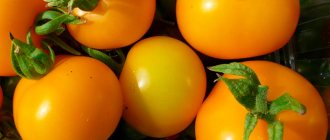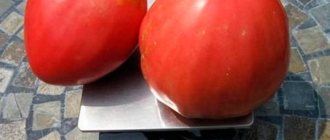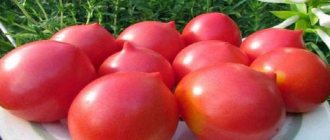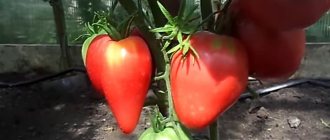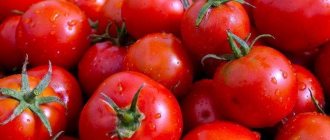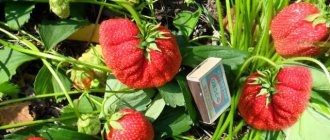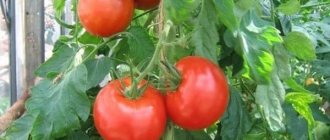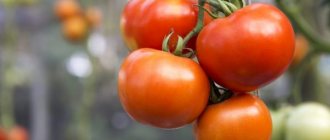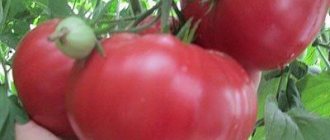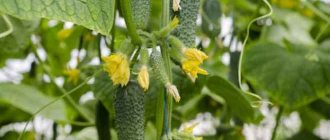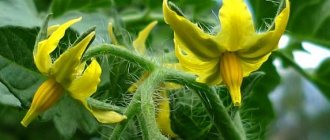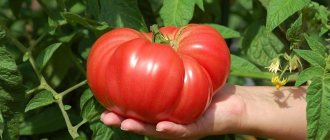The Sevruga tomato is also known as Pudovik. This is a delicious variety of reddish-raspberry tomatoes, large, with a rich taste and aroma that evokes thoughts of real summer.
| Height | Landing location | Ripening time | Fruit color | Fruit size | Origin | Fruit shape |
| Tall | Greenhouse | Mid-season | Bicolor | Large | Variety | Heart-shaped |
Planting and care
The characteristics indicate that Pudovik is suitable for all regions, but it is better to plant the variety in cool climates. In the south, it may not correspond to the description, although it bears fruit and requires increased attention. So it makes no sense to grow it there. Moreover, there are many other good-yielding tomato varieties for warm regions.
Sowing seeds
Seeds for seedlings are sown 55-60 days before planting. Tomatoes are placed in beds when the ground warms up to 15° C. In greenhouses - up to 10° C. The exact time depends on the region and weather forecasts.
You can focus on the following timing for sowing Pudovik tomatoes for seedlings:
| Regions | Greenhouses | Open ground |
| Middle lane | beginning – mid March | mid-March – early April |
| North-West, Siberia, Ural | second half of March | beginning – mid-April |
Features of care
In the Middle Zone and Siberia, the Sevruga tomato has proven itself, according to reviews, to be a fairly stable and not too demanding variety. It needs to be fed regularly so that the fruits become full and do not become smaller.
It is necessary to ensure that phosphorus-potassium fertilizers predominate in Pudovik’s “diet”. Nitrogen is definitely needed (it is the building material for the plant), but in very limited quantities. Otherwise, the tomato will increase its green mass to the detriment of fruiting and will become vulnerable to pests and pathogens.
The care package must include preventive treatments. The Pudovik tomato is quite demanding when it comes to watering. But it is impossible to over-moisten the soil - this leads to cracking of tomatoes, rot, and provokes the development of other diseases.
Bush formation
The Sevruga tomato variety requires pinching and tying to a support from an early age. The lower leaves are removed only when the ovary above them begins to fill. Pudovik can be grown in 1 or 2 trunks.
To obtain large tomatoes, pinch the brushes. To grow truly gigantic fruits weighing 1-1.5 kg, you will only have to leave a few ovaries on the bush.
Tomato Sevruga (Pudovik)
Tomatoes of the Sevruga variety delight me every summer with large and tasty fruits. The bush is spreading and loose, about 170 cm tall, I definitely tie up my stepson too. My sister grows this variety in her garden in the south, but in my Urals it only grows in a greenhouse. It really doesn’t like cold and rain, in the wet summer it gets sick in the open ground and produces little yield, and the main thing is not to overwater it in the greenhouse - the fruits will be watery and crack. In warm summers, I collect a bucket of large fruits from 3-4 bushes; in total, I get 3 harvests over the summer. A salad variety, good in summer dishes when fresh - juicy, sweet, delicate consistency.
The variety is average and requires standard care. Suitable for beginner gardeners. Does not require constant presence at the dacha. The bushes have a growth limit, reaching a maximum of 1.8 meters. Maximum yield can be achieved when forming 1 or 2 stems. You have to spend time building trellises and tying them up; you can’t do without pinching. When planting in open ground, good results were not achieved. The best varietal qualities are revealed when planted in a polycarbonate greenhouse. Regular ventilation is required. Ripe fruits have a beautiful heart-shaped shape and a rich, uniform crimson skin color. Compact planting is absolutely not suitable. For 1 sq. per meter it is permissible to place no more than 3 plants. Resistance to diseases is high. Pests are moderately interested in the variety. 1-2 preventive treatments with fungicides and insecticides are enough. The tomatoes are very tasty, the flesh is juicy, the aroma is pronounced. Seed chambers are small in size. The dense skin ensures long-term preservation of the crop. During transportation, it does not crack and the pulp is not deformed. Large fruits are not always suitable for whole-fruit canning, but they go great in salads, juices and pastes.
Beautiful, very large tomatoes. In my case, during the most ordinary cultivation without enhanced agricultural technology, the weight of the fruits is never less than 400 grams, and especially large ones barely fit in the palm of my hand. You take 1 piece and it’s enough for a salad. Due to their size, they are not suitable for canning, but are suitable for juice, making sauces and snacks. I have been growing Sevruga for a long time, I used to buy seeds from Sibsad, then I switched to my own. I tried the greenhouse and open ground, there were no problems in both cases, but in protected ground the harvest was greater. Over the years I have not encountered any illnesses. A productive variety that produces several full-sized clusters under any conditions. I live in Krasnoyarsk, summers can be rainy, but even in such conditions I still get a harvest of 2.5 kg per bush, and if the summer is sunny, then it reaches 5 kg. For greater success, you should plant it in 2 stems; I tried one, and the bushes turned out stunted. The fruits are flat-round, pale in appearance, but bright red inside. The pulp is very soft and the skin is delicate; when I collect it, I accidentally press it down a lot; it’s impossible to store it in 2 layers, and there’s no question of transportation. This is a wonderful productive variety that does not cause trouble, does not get sick and tastes very good.
The variety is ideal for growing in the difficult climatic conditions of Siberia. Returning spring frosts, prolonged heat and short summers do not affect the formation of ovaries, productivity and consumer qualities of ripe fruits. When forming a bush with 1 stem, there is a growth point. If you leave more stems, then only 1 has a growth limit. Just in case, I leave 1 spare stepson so that the bush always has the opportunity for further development. The final height of the bush directly depends on the planting conditions. In open ground, plants rarely exceed 80 cm; in a greenhouse they grow up to 1.5 meters. The stems and branches are weak and fall to the ground under their own weight; without organizing supports and proper tying, cultivation is impossible. The harvest ripens under cover in 3.5 months; in ordinary beds you have to wait 4. Each bush produces up to 5 kg of tasty, juicy and aromatic tomatoes. High-quality care and feeding can increase this figure to 6-7 kg. If plants are damaged as a result of drought or frost, self-healing occurs quickly. Resistance to common diseases is high, using a minimum amount of chemicals.
Growing
Open ground is more suitable for growing tomatoes. They take root well in greenhouses, but in such conditions they need more careful care. Usually the harvest in them is not so large.
():
In protected soil conditions, the tomato yield is, as a rule, much higher than in open soil. Firstly, the duration of the growing season in a greenhouse is longer, which means that indeterminate tomatoes will bear fruit for a longer period of time. Secondly, the greenhouse protects against all unfavorable factors that can reduce the yield: cold snap, hail, pest invasion, strong wind.
Before sowing, it is necessary to prepare Sevruga tomato seeds. First, salt water is heated to 50-60 °, and then the seeds are placed in it. Pop-up ones must be removed immediately: they are not suitable for sowing. Those that have sunk to the bottom are removed from the water, washed, dried, and then used to grow seedlings.
Sowing seeds for seedlings
Sowing seeds for seedlings is carried out according to a certain scheme, the description of which will help you do everything correctly:
- first prepare containers for sowing seeds;
- they are filled with garden soil mixed with humus and river sand, which will make the soil more loose;
- make small depressions on the surface of the soil. The distance between them should not be more than 2 cm and less than 1 cm;
- Seeds are placed in them and covered with another layer of earth. The thickness of the earth layer should be no more than 5-6 mm;
- Water the seeds very carefully so that they do not go deep.
How to effectively use aloe vera to treat sunburn
Use film to speed up the growth of seedlings. It covers containers with future shoots.
Transplanting seedlings
Characteristics of the tomato variety Sevruga states that only those seedlings that are 60-65 days old are allowed to be transplanted into open ground. It is important that by this time they already have 2-3 sheets formed.
():
At the age of 60-65 days, the seedlings are already about 30 cm high and have at least 5-6 formed leaves. But it is not necessary to grow such large seedlings. It is difficult to transport to the planting site (it wrinkles and breaks), it takes root less well, and it “sicks” longer after transplantation. Seedlings 35-45 days old are more suitable for transplanting. Its height is 15-18 cm, it takes root very quickly.
Choose a planting site with good lighting and protected from the wind. The soil should be saturated with useful substances. Before planting seedlings, fertilize the soil with superphosphate.
Make shallow holes in the ground, the distance between which should be at least 40 cm. It is better to leave 70-80 cm between the rows. Seedlings are planted in the prepared holes so that the roots in them are distributed evenly. After this, watering is carried out.
Advantages and disadvantages
More and more often you can find gardeners who plant this variety in their garden plots. This popularity can be explained by a lot of its positive qualities. However, its shortcomings have not been identified to date.
Advantages:
- tomato is extremely resistant to its characteristic diseases;
- the variety is easy to care for and not difficult to grow;
- ovaries form in any environment;
- high productivity;
- large fruit;
- excellent taste and versatility in purpose;
- long-term storage.
The Sevruga tomato is so unpretentious to grow that even a beginner can master this process. Therefore, the variety can be called one of the favorites among gardeners.
Pros and cons of the variety
Advantages
The Sevruga tomato variety has several undeniable advantages:
- The plant brings a good harvest - up to 15 kg can be harvested from one square meter;
- The fruits are very tasty and juicy. They are stored for a long time;
- This variety is resistant to changes in weather conditions, tolerates humidity or drought well and is frost-resistant;
- The fruits always set well, this does not depend on the environment;
- They have good disease resistance;
- Juicy fruits can be eaten either freshly picked or added to dish recipes, to prepare excellent tomato juice;
- The Sevruga tomato bears fruit in cycles that constantly replace each other, so you can constantly harvest from the bush.
Flaws
The Sevruga tomato has no significant disadvantages. The disadvantages include:
- The impossibility of using the whole fruit in canning. If this is the goal, then you should choose a different tomato variety;
- Weak leg. An adult bush must be tied up so that the plant does not break under the weight of the fruit.
More and more amateur gardeners prefer the Sevruga variety for its ability to grow in open garden plots and in greenhouses. If you follow simple rules for caring for the plant, you can collect large and juicy fruits throughout the entire fruiting period. The geography of growth throughout Russia and resistance to cold and temperature changes make the Sevruga tomato a favorite among other tomato varieties.
Productivity
The fruits of Sevruga often reach one kilogram. Therefore, the fruits look very impressive. One bush of these tomatoes usually produces about five kilograms of fruit. The average weight of one fruit is approximately 800-900 grams. The tomato needs a dive, then everything will be fine. Don't forget to harden off the seedlings. I didn’t notice any significant disadvantages, a very tasty harvest.
Read also: Cucumber competitor: reviews, description, cultivation and photos
Ekaterina, Moscow region This variety feels best at a temperature of +20°+23°C, tested. He doesn’t like higher temperatures, but since our summers are usually cool, this doesn’t pose a problem. If you have a fever, then it is better to avoid Sevruga.
Elizaveta, Moscow region. I advise you not to overfeed the tomato with fertilizers, otherwise it will crack. And watering should be moderate, otherwise the appearance of the tomatoes will suffer. Instead of heavy watering, I use mulching. You can use straw or sawdust, it doesn’t matter. This saves effort, time and the tomatoes will not crack.
Sergey, Tver It seemed to me that this variety does not like watering, but rather likes drought. I read the article and realized that this is indeed true. The yield is excellent, I have never been sick. I highly recommend it to everyone!
Lisa, Krasnodar region
The tomato needs a dive, then everything will be fine. Don't forget to harden off the seedlings. I didn’t notice any significant disadvantages, a very tasty harvest.
Similar varieties
The Sevruga tomato is similar in characteristics and description of the variety to the following tomatoes:
- Dad. Very reminiscent of Pudovik, only indeterminate. Mid-season, disease resistant. Fleshy, heart-shaped fruits of raspberry color weigh about 350 g. Productivity is up to 17 kg per 1 square meter.
- Pink honey Determinate, but grows significantly lower than Pudovik. Mid-season tomato with pink, heart-shaped fruits weighing 300-600 g. Yields up to 6 kg per bush. Disease resistance is low.
- Nobleman. Mid-season, determinate, heart-shaped, raspberry, fleshy. The fruits weigh 200-300 g, the yield per bush is 3-5 kg. Disease resistance is low.
- Mazarin. Determinate hybrid. The fruits are round-heart-shaped, fleshy, weighing about 200 g. From 1 sq. m you can harvest 14 kg of tomatoes. Unlike Pudovik, early ripening. High resistance to diseases.
- Oxheart is a semi-determinate tomato, mid-season, with large, fleshy red heart-shaped fruits. Weight – 350 g, but can reach 1 or more kg. From 1 m2 they harvest 7 kg of tomatoes in the ground; for a greenhouse the figure is higher – 11 kg. Disease resistance is low.
Tomato Sevruga or Pudovik is one of the best varieties for risky farming areas. It ripens even in open ground, is resistant to diseases, and does not require special care, except for the obligatory garters and pinching.
Tomato “Sevruga” – or “Pudovik”?
Sometimes on packets of seeds they write “Pudovik tomato” (Sevruga).”
However, there is a lot of stuff written on the packets of seeds. We still need to figure it out. The State Register of Breeding Achievements does not include the Sevruga variety, but Pudovik does. It is noted on Tatianastomatobase that these varieties are similar and, according to a number of sources, the names are synonyms of the same variety. Finding these sources is not difficult, there are many of them. Therefore, for now I will consider these two varieties as one, and if new data appears, I will make changes to the article.
The tomato variety “Pudovik” was bred by Vladimir Nikolaevich Dederko and Olga Valentinovna Postnikova and registered in the State Register in 2007 as a variety for amateur cultivation in open ground and greenhouses. The originators are the authors themselves - who, by the way, created many other tomato varieties - for example, the “Pink Honey” variety.
Characteristics
| Type | indeterminate |
| Plant height | up to 250 cm |
| Fruit | heart-shaped, ribbed, weighing up to 500 (usually about 250..300) grams, red |
| Taste | great |
| Ripening period | mid-season, about 110 days |
| Disease resistance | no evidence of stability |
Description
"Sevruga" is an indeterminate tomato variety. Difficulties arose with the height of the bush: according to various sources, the height ranges from 120 to 250 cm. In my greenhouse in 2015, the bushes grew to approximately a height of 120...130 cm by the beginning of August; I did not plant this variety in 2021. The Register does not indicate the plant height for the Pudovik tomato.
The leaves are large and green. The plant itself is quite branched and easily lies down under its own weight.
The inflorescence is a simple raceme, a stalk with an articulation. Sevryuga tomatoes are large, weighing about 300, and often more than 500 grams. There are reviews that mention fruits weighing 1.4 kg. The fruits themselves are heart-shaped, ribbed, and of medium density. The color of ripe tomatoes is raspberry. Nests with seeds at least 4.
Tomato "Pudovik" is intended for fresh use; The fruits have an excellent taste, the pulp is moderately soft and very juicy. Some amateur cooks use these tomatoes to make juice.
Features of cultivation
The “Sevruga” tomato (I note once again that it is registered in the State Register as “Pudovik”) is approved for cultivation in all regions of Russia in open ground and under film covers. In my modest experience, open ground in the Moscow region and to the north should be excluded: in a good summer, “Sevryuga” will ripen there, but will not realize its yield potential.
I planted it in a 70 x 60 pattern to give the plants more space and to form two full stems. In principle, this planting scheme and method of pinching (more about how to pinching tomatoes) suited me - there were a lot of tomatoes. True, the summer was hot, and I did not spare any watering (read more about watering tomatoes) or other efforts, mercilessly cutting out the stepsons every week. As a result, significantly more than 5 kg were collected from each plant, which together probably gave the required 15.5 kg/m2 according to the register. I am sure that in open ground the results would be much worse.
The variety is mid-season: from the emergence of seedlings to the beginning of ripening, it usually takes about 110 days.
There is no information about the variety's resistance to diseases. In my case, this variety suffered from late blight in the same way as the others.
Advantages
- high productivity;
- attractive appearance of the fruit;
- excellent fruit taste.
Flaws
As far as I can tell, there are none. Therefore, I consider Sevryuga one of the best tomato varieties for greenhouses.
Reviews
My personal review of Sevruga is strictly positive. This is a very productive variety that produces very tasty fruits. Other gardeners generally share my opinion: I cannot remember any obvious negative things about Sevruga. However, there are references to the fact that hard fibrous areas may appear inside tomatoes, but this, in my opinion, indicates an imbalance in the mineral nutrition of the plant.
If you have experience growing Pudovik tomato, please leave your feedback in the comments to the article. Thank you very much.
Reviews from gardeners
Many gardeners speak positively about the Sevruga tomato. They note that even an inexperienced gardener can easily cope with growing the variety. The plant is unpretentious, grows well in different climatic conditions, but it is necessary that nothing on the site darken the bushes. Otherwise, they cease to demonstrate high productivity.
The best men's winter jackets: rating of the warmest and highest quality models
Disease resistance is a significant advantage of tomatoes. Thanks to simple prevention, the appearance of pests can also be prevented, so there is practically no threat to the harvest.
Tomatoes of the Sevruga variety have good taste characteristics, which make it possible to make excellent preserves from them, but it is not always convenient to use these vegetables for this purpose due to their size, because some fruits reach 1 kg in weight.
Characteristic
Sevruga are tomatoes that are resistant to different climatic conditions. The variety tolerates long-term storage well. There are no problems during transportation due to the dense skin, which reliably protects the fruits from mechanical damage.
You can grow Sevruga tomatoes in any area. They take root better in open ground, but even in greenhouse conditions with proper care they can produce a good harvest.
Productivity and fruiting
Fruit ripening time is 110 days. The bushes bear fruit well. They always yield a rich harvest.
One bush can produce up to 5 kg of tomatoes. Often the figures reach 6-7 kg per bush. It is important that no more than 4 plants are placed per 1 m², otherwise the yield will decrease.
Resistance to diseases and pests
The Sevruga tomato is resistant to various fungal infections, but some pests can attack the bushes from time to time:
- spider mite;
- Colorado beetle;
- aphid.
With proper prevention, their occurrence can be easily avoided. In this case, they will not pose a threat to the plant itself and its fruits. Preventive measures will also prevent infection with other types of infections.
Area of application of fruits
Tomatoes of this variety are eaten not only fresh. Their taste makes them an excellent raw material for making juices. Tomatoes make delicious sauces that are added to various salads and other dishes.
Tomatoes are delicious fresh
They are also used as an ingredient for salads. Stellate sturgeon is often grown for canning, but due to the large size of most fruits, it is not possible to preserve them in their entirety.
Advantages and disadvantages
According to the description of the Sevruga tomato, it has the following advantages:
- ease of cultivation;
- ease of care;
- high productivity;
- ability to set fruit under any conditions;
- resistance to damage;
- high taste characteristics of tomatoes;
- disease resistance.
No significant deficiencies of the variety were noticed.
Agricultural technology
Priming
In order for the seedlings to turn out to be of high quality, it is important to prepare the soil. You can buy it in the store - there is a special soil for tomatoes, or you can make it yourself. To do this, you need to take equal parts of humus soil and ordinary soil from the garden and mix them. If desired, you can add peat and sawdust to create a more nutritious environment in the soil. To disinfect the prepared soil, calcination is used in an oven, and then it is placed in a damp room for a week to create beneficial microflora.
If the soil is purchased in a store, then it should not contain fresh organic matter, which can lead to the death of seeds due to the decomposition of organic substances in the soil itself, as well as the content of sand and clay, which contribute to its compaction.
To grow the Sevruga tomato variety, the following sequence is used:
- planting seeds in the ground;
- picking;
- planting sprouts in the soil.
Basically, the tomato ripens in August, three to four months from the start of seed germination.
Planting seeds
They begin to sow tomato seeds in early spring, throughout the month of March. From the moment of sowing the seeds, the subsequent stage of picking until planting at a permanent place of growth, it takes two and a half months.
To create seedlings, soil and boxes prepared in advance with a special composition are used, intended for germinating seeds.
As a rule, seed germination occurs unevenly over time; to improve their germination, it is worth pre-soaking them for a day in a special growth stimulator, which is sold in the store. To disinfect, they can be placed in a 1% manganese solution for half an hour.
For sowing seeds, as a rule, a box with a shallow bottom is used. 5 cm of soil is poured into it and moistened. Then you need to make furrows one centimeter deep, at a distance of four centimeters from each other. The seeds are planted to a depth of three centimeters and sprinkled with soil.
The temperature should be from +23 to +25 degrees. To maintain it, a film is used to cover the box. It is better to place it near the battery.
Shoots should appear in a week if the temperature and humidity conditions have not been disturbed.
Picking
The next important step is picking. It is necessary for the development of strong roots, normal plant growth and to ensure good yield.
After emergence of seedlings, the ambient temperature should be lowered to +16 degrees at night and to + 22 degrees during the day, now the plants need light. If these rules are followed, the sprouts will not stretch, since the Sevryuga variety is characterized by the thinness of the plant trunks.
To do this, periodically remove the film from the box and wipe off the condensation so that the soil is not over-moistened and mold does not grow in it.
When the sprouts acquire leaves, this should happen within a week, you should proceed directly to picking.
You need to plant in peat cups no more than 0.5 liters in volume. After transplantation, young plants need to be fertilized.
Seedling
Two months after the sprouts emerge, they are transplanted into holes in the ground. You need to fill the plant with a pre-prepared mixture of humus, peat and compost, taken in equal parts. Superphosphate is added to this mixture at the rate of one tablespoon per 10 liters of mixture. Plants are fertilized with it once every two weeks.
Young seedlings should be watered with warm water, preferably settled, as needed. After watering, be sure to loosen the soil.
As a rule, seedlings are planted in the ground in June, when there will definitely be no frost. Some gardeners pre-harden off plants if there is a chance of cold nights.
Landing Features:
- There should not be more than three tomato bushes on one square meter, as the plant grows over time;
- If the seedlings have stretched out, then you need to carefully tear off the leaves and leave only the top. Then plant the plant in a hole that is dug lengthwise, leaving only the top on the surface. This method serves to strengthen the roots due to the appearance of new ones on the stem;
- It is worth installing pegs in advance to secure the plant as it grows.
Care
Caring for a tomato consists of periodic watering at least once a week; you should also remember to remove the shoots as they grow. The fruits set at a temperature of about + 22 degrees, therefore, if the plant is in a greenhouse, then it is worth periodically ventilating it and monitoring the humidity, an excess of which can cause diseases.
You need to water generously, but not with cold water. It is advisable to let the water stand for 24 hours. You need to pour water directly under the root and make sure that the soil around it does not erode. The best time is morning or after sunset.
